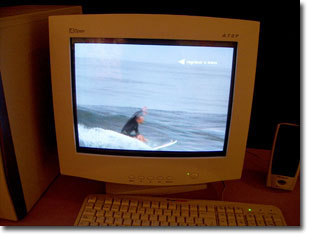Centro Cultural Olimpo,
Jul 16, 2005 - Jul 25, 2005
Mérida, Yucatan, Mexico
The biennale InteractivA 05
by Eduardo Navas
With this in mind we can consider the work presented by Fuss, "Ambientador," which gives agency to the user to become a DJ/VJ with software that can be constantly customized and improved; here, the participant has the agency to create personal interpretations for expression in a performance, or be a spectator when someone performs for an audience; also we can consider the three part curatorial contribution by Lucrezia Cippitelli which explores and questions time-based media's rapid change and its effect on the viewer's notion of uniqueness in time, with material that is created on the fly; this work reconsiders how narratives now can be customized for a specific moment and never repeated--one would wonder if individuality is being reinforced or questioned with some of the pieces. We can also consider Maria Luisa Molina López's lecture, which left the audience with open questions about the hybrid state of Chicano/a culture and its relation to Mexican culture, and how technology plays, both, a conflictive and a productive role in their ongoing developments. Also, Guestroom explores the possibilities of print as an exhibition space in large part thanks to the efficiency of current technology; Raquel Herrera Ferrer explores new media projects which enrich the possibilities of narratives; and The Tijuana collective Bulbo takes advantage of technology to develop videos, interactive DVDs and print publications, all exploring the current state of flux of Tijuana. In contrast Amelia Farfán Góngora explains how new technologies while they are great when they work properly are not always beneficial to the classroom if there is no clear understanding how the teacher is to function when TV education is largely non-functional. Heidi Figueroa exposed how new modes of communication while they are certainly bringing people closer with their communities function on cultural codes that must be kept in check so that the devices do not become apprehensive on the psychology of the individual. And subRosa showed how because of new technologies it is easier to support the black market of human body parts, while also explaining that with awareness the same tools can be used to intervene and contest the problem. When acknowledging the complexity of these examples, one realizes that it is possible to use technology productively, regardless of its many problems and shortcomings.
Ultimately, even with this criticism in mind, it is undeniable that InteractivA 05 was an impressive and successful biennale which demonstrated that there is a strong network of emerging artists, writers and curators who will redefine the current paradigms as well as create new paradigms in the near future. The biennale's strength lies in bringing together diverse works and individuals--including some which clearly questioned the exhibition's curatorial premise.
The energy level throughout the nine days was really intense and everyone was eager to exchange ideas and talk about their own local experiences. It was mainly during the dinners when the participants were able to express their ideas.
Given that many of the people were transnationals, conversations often moved from the politics of the countries they were born in to the countries in which they currently live or had lived. This was a set of people who were highly aware of global politics.
Balanquet announced that there would be no more InteractivA biennales; that if anything happened it would be in the form of a traveling exhibition. It might be time for InteractivA to hybridize into something else, let's just hope that such hybrid, if it is to keep its current underlying focus on post-colonialism, is more open to understanding notions of post-colonization that deal with possibilities for integration rather than binary division. Considering Balanquet's post-colonial position (even if it appears reductive with some of the work), one can only wish that--within such paradigm--everyone in the future can speak, whether they have been colonized or have colonized, this however is not a reality yet. It is usually one side or the other that takes center stage; admittedly, it is still the colonizer who does most of the time. Changing this is the real struggle in the future. Towards this InteractivA 05, full of rich cultural conflicts, has become the third and perhaps last of the three challenging Biennales in Mérida, Yucatán.
To speak is to fight--
Jean Francois Lyotard .[8]
[1]Guillermo Bonfil Batalla, México Profundo (Austin, Texas: University of Texas Press, 1996), 65-66.
[2]This comment is made based on the conference "Mexico in the Nineties" which I attended at UCSD during the Spring quarter of 2005. Various intellectuals from Mexico City presented on Mexican culture and its current influence in the arts. The book was heavily mentioned.
[3]Batalla, xiii.
[4]Jean Francois Lyotard, The Postmodern Condition (Minnessota: University of Minnesota Press, 1984). This book explicitly defines the development of metanarratives and their move toward specialization which lead to little narratives
[5] Raul Moarquech Ferrera-Balanquet, "El Futuro Postecnólogico de Arte Actual comenzó Ayer," Arte Nuevo InteractivA 05 (Merida: Ayuntamiento de Merida, 2005), 5.
[6] Ferrera-Balanquet, 8.
[7] Ibid, 7-8.
[8]Lyotard, 10.
|







